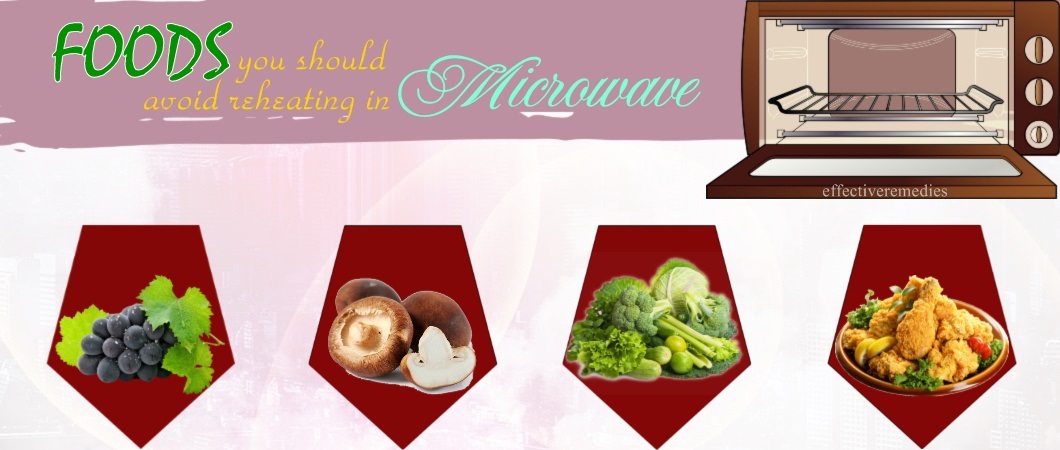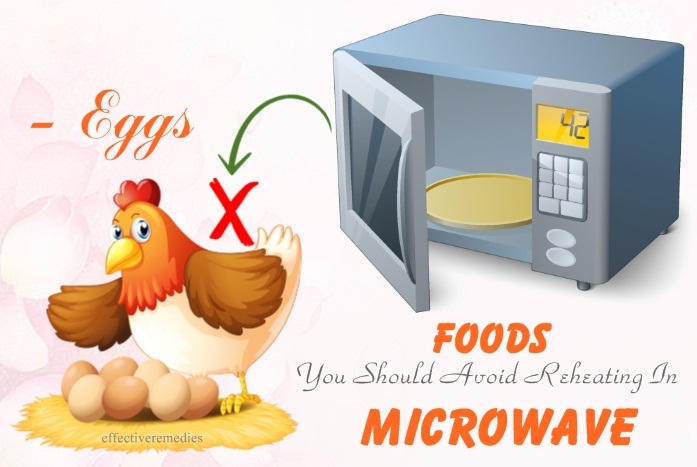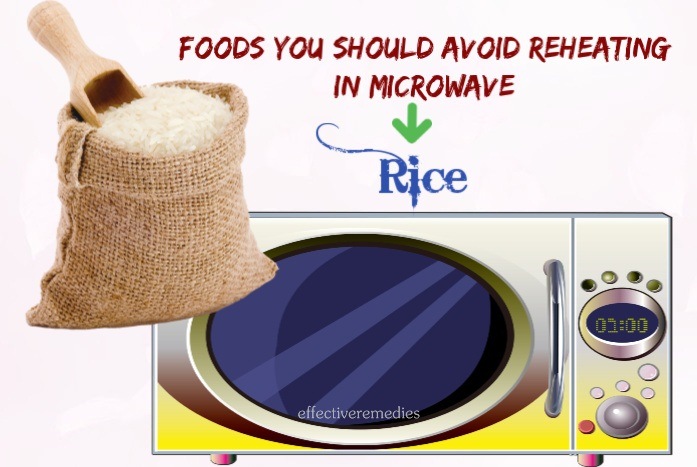Table Of Contents
Nowadays, microwave appears in every kitchen due to its convenience in cooking and reheating food. For example, a survey conducted in the UK showed that from 1994 to 2018, the households own a microwave increased remarkably from 67% to 93%[1]. Microwave ovens heat food faster compared with oven or pan. People often use this machine to reheat leftover foods, make simple meals, and prepare other ingredients used for cooking such as butter. Imagine that thanks to microwave, you can save time when you can cook the meals for 3 or 4 days, keep them in the fridge, use the microwave to reheat and enjoy them. However, not all the food can be reheated in the microwave because they can cause food poisoning https://effectiveremedies.com/home-remedies-for-food-poisoning/ or make some dangerous phenomenon leading to injury. In this post on EffectiveRemedies, we will talk about 10 food you should avoid reheating in the microwave. Some food you might think it is safe when being put in the microwave but the answer is no. We hope that after reading post, you will be more careful when choosing food to reheat in the microwave.
Top 10 Foods You Should Avoid Reheating In Microwave For Safety Reasons
1. Breast Milk
Many mothers choose to reserve the breast milk in the fridge in case anyone can feed the babies. When the baby is hungry, many parents tend to use a microwave oven to warm breast milk. The babies do not have to wait too long because this process occurs rapidly. However, it is advisable to avoid heating breast milk by using a microwave oven. According to the La Leche League International, microwave can heat milk unevenly, which means that milk can have some hot spots, which burn your baby’s mouth. It is not easy to control the temperature in a microwave so that the babies can be scaled easily. Moreover, breast milk is a living fluid. Microwave can destroy valuable immunological components by causing denaturation and inactivation of milk’s bioactive proteins and reducing fat content[2]. Instead of using the microwave to warm the milk, the University of Rochester recommended thawing the breast milk by keeping the frozen container in the refrigerator the night before using it. After that, we can put the milk bottle in the warm bowl to warm the milk[3]. Besides, now we can easily find some products specialized in warming milk, which are not expensive and ensure the quality of milk after being warmed.
2. Chicken
We have to know that heating by microwaves does not always kill bacteria due to the mechanism of heating from the outside in instead of the inside out[4]. That is the reason why some bacterial cells survive when you cook chicken with a microwave. As stated by the Centers for Disease Control and Prevention, undercooked chicken contains Salmonella, which causes food poisoning[5]. A study conducted with 30 participants showed that all 10 people who used a microwave to reheat raw meat became ill while 20 people who reheated by a skillet were fine[6]. Therefore, you can use a microwave oven to warm the chicken after making sure that you cook it completely to eliminate all present bacteria.
3. Eggs
Although reheat a boiled egg in the microwave oven helps you save time, you should not do it because the result will disappoint you. A letter from ophthalmologists to the British Medical Journal described a case of a nine-year-old girl. After being reheated a boiled egg in a microwave for 40 seconds, the egg exploded, resulting in a lens replacement in her eyes[7]. According to a review in 2001 of the medical literature, 13 cases suffered from injuries, mostly burns coming from the explosion of microwaved eggs[7]. Moreover, eggs in the shell can also explode in the microwave oven. Incredible Egg[8] explains that this phenomenon happens because of a buildup of steam within the egg. Building steam too fast makes egg breathe through its pores leading to a messy explosion.
4. Frozen Meats
Sometimes, we are too busy to remember that we have to defrost the meat before cooking. At that time, we tend to choose the microwave due to its speed. However, according to Prof Costas Stathopoulos, of Abertay University in Dundee, we should not use the microwave to thaw meat[9]. He pointed out that it is unsafe to reheat frozen food because this process would multiply bacteria. The microwave often unevenly thaws the meat resulting in the growth of bacteria mixed with partially cooked meat. According to Health Canada, you can thaw meat in the microwave if you cook meat after right away[10]. However, instead of using the microwave to defrost the meat, you should put the meat in the fridge and let it defrost gradually.
5. Processed Meat
Processed meats are becoming more and more popular due to their convenience. However, we should not consume them regularly because the manufacturers add food additives, which can harm the health to processed food to increase palatability, modify texture, and prolong shelf life[11]. This type of meat also becomes more unsafe when being reheated in the microwave. A study in 2015 about the cooking methods for processed meat (frankfurter sausage, loin ham, bacon, etc) stated that in comparison with other cooking methods, microwaving and oven grilling caused a higher amount of cholesterol oxidation products (COPs)[12], which are the reason for the development of coronary heart disease[13]. Another study claimed that COPs cause inflammation, plaque buildup in the arteries, and more health conditions[14].
EffectiveRemedies Partner Solutions

Ask a Doctor Online and Get Answers in Minutes, Anytime!
Have medical questions? Keep asking questions to a Verified Expert until you get the answer you need.
6. Hot Peppers
A chemical called capsaicin found in hot peppers creates the spicy flavor. Heating peppers by microwaving makes the capsaicin in them vaporize into air leading to the burning of your lungs, throat, eyes, and nose[15]. In fact, an apartment building in New York was evacuated because of microwaved pepper making residents start coughing and find it difficult to breath[16].
7. Grapes
We can see the energy break out in a flash when putting the grapes in the microwave. This flash is called “plasma.” The researchers in Canada[17] explained that when two grapes sit next to each other, there is a hot pot at the point where the grapes touch, resulting in charge or ionization of salts within the grape skin, then creating the plasma. This phenomenon makes a mess of microwave oven, even damages this oven.
8. Green Leafy Vegetables
Green leafy vegetables such as spinach and celery are the source of nitrate which lowers the risk of cardiovascular disease[18]. “Spinach is also a great source of minerals and vitamins such as vitamin B, vitamin C, vitamin E, calcium, iron, potassium, magnesium, and omega-3 fatty acids which are needed for healthy skin.” (Medically reviewed/fact checked by Sarah Brewer MSc , MA (Cantab), MB, BChir, RNutr, MBANT, CNHC. Read more at here). However, according to the European Food Information Council (EUFIC), we should avoid reheating the green leafy vegetables. Reheating (the function of microwave) this type of veggies will make the nitrate become nitrosamines thanks to high temperature and acidic environment[19]. The Environmental Working Group stated that some of the nitrosamines could cause cancer such as stomach, esophageal and lung cancers and tumors in multiple organs, including the liver, stomach, lungs, kidneys, and blood[20].
9. Rice
According to the Food Standards Agency, you may have food poisoning if you eat reheated rice[21]. The National Health Service explained that uncooked rice has spores of Bacillus cereus, which can cause food poisoning. The spores can survive even when the rice is cooked. Room temperature is a suitable environment for the bacteria development resulting in vomiting or diarrhea. At that time, reheating rice in the microwave cannot kill these bacteria[22]. Thus, the solution to this problem is consuming the rice after it has been cooked. In case we have rice left, cool the rice as soon as possible and put it into the fridge. Remember to avoid reheating rice more than once.
10. Mushroom
The European Food Information Council showed that it is easy for enzymes and microorganisms to destroy the proteins in mushrooms[23]. Therefore, we have to store mushrooms properly before reheating, or we will have an upset stomach. The Council also reported that we could reheat mushrooms at recommended temperatures of 70 degrees after storing them for not more than24 hours.
Microwave has become an indispensable part of life, which helps us save time and energy when cooking. However, it is advisable for us to consider before we microwave any kind of food to keep their good natural nutrition and avoid the chemical changes in food, which can cause injury and toxic as well. Besides, if you have children, you have to be careful when letting your children use the microwave to prevent unpredictable problems.
We have a comment box below for you to leave your questions or comments about our topic today. Even you agree or disagree with the information above; please let us know. We are very happy to hear your opinions. Also, share with us if you know other foods you should avoid reheating in microwave. In short, please visit the New & Fact page to read more about the habits which are good or bad for your health. All content provided is for informational & educational purposes. We recommend you consult a healthcare professional to determine exactly which food you can reheat/cook in the microwave. In particular, you can also ask the doctor about the cooking methods, including microwaving to keep their nutrition and their flavor as much as possible.










